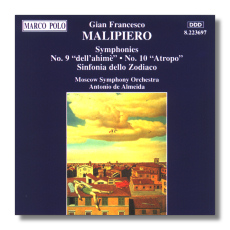
The Internet's Premier Classical Music Source
Related Links
- Latest Reviews
- More Reviews
-
By Composer
-
Collections
DVD & Blu-ray
Books
Concert Reviews
Articles/Interviews
Software
Audio
Search Amazon
Recommended Links
Site News
 CD Review
CD Review
Gian Francesco Malipiero

- Sinfonia dello Zodiaco (1951)
- Symphony #9 "dell'ahime" (1966)
- Symphony #10 "Atropo" (1967)
Moscow Symphony Orchestra/Antonio de Almeida
Marco Polo 8.223697 - 71min
The most immediately accessible item in this collection - the final installment in Marco Polo's survey of the complete Malipiero symphonies - is the unnumbered Zodiac Symphony. More a suite than a traditional symphony, it consists of twelve short movements (none more than five minutes in length) arranged into four "partitas" representing the seasons of the year rather than any astrological phenomena. While the composer's inspiration does flag on more than one occasion in the course of this forty minute work, his descriptive powers, melodic invention, and gift for vividly colorful scoring all ensure that it is a generally satisfying musical experience. Memorable moments include an enchanting pastoral dialog for oboe and english horn at the beginning of Spring and the spooky sponticello string writing which sets the stage for winter.
The two numbered symphonies in this volume deal with darker, more serious subjects. The bustling allegro finale of Malipiero's Ninth is interrupted by a drum roll over which the trumpets blare out an ominous two note figure. The word "AHIME" is printed at this point in the score. This "shamelessly naïve outburst" (as annotator John C.G. Waterhouse describes it) gives this quirky, dissonant, and unsettling score its enigmatic subtitle: "Dell'ahime" - or, in English, "Of the Alas". The highlight of the work is not this episodic finale, but rather the haunting middle movement which is dominated by an exotic and highly expressive English horn melody.
Malipiero dedicated his next symphony to the memory of his friend Hermann Scherchen, who collapsed and died in 1966 after leading a performance of the composer's early operatic triptych L'Orfeide. Indeed, the Symphony's subtitle, Atropo, refers to the mythical Fate who cuts the thread of a person's life at the moment of death; both I and II conclude abruptly - cut off in the midst of a phrase. The Symphony begins in an striking manner with a theme from the opera superimposed over a funereal rhythm articulated by the lower instruments. The closing bars of the Symphony derive from the end of the opera - the very last music that Scherchen conducted. I hear none of the "stylistic dichotomies and awkward transitions" that Waterhouse complains about. Instead, this uniquely powerful score brilliantly integrates themes from Malipiero's youthful opera into a heartfelt elegy for one of this century's most brilliant conductors.
The Moscow Symphony struggles valiantly with the unfamiliar idiom of these three works, but its thin, wiry strings are simply not up to the considerable demands of this music. Perhaps in an effort to hide the unpleasant shrillness of the violins, Marco Polo heaps on copious amounts of reverberation. Nonetheless, this new disc will serve as an excellent introduction to his symphonies - my reservations about the orchestra notwithstanding.
Copyright © 1998, Tom Godell


















